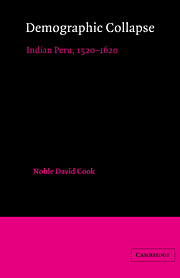Introduction: The problem in perspective
Published online by Cambridge University Press: 02 December 2009
Summary
We are now in a period of marked disagreement about the size of former Indian populations, both regionally and for the hemisphere, with a strongly realized need for resolution based on better techniques and evidence.
William M. Denevan, Native Population, p. xixThe controversy over the size of the aboriginal population of the Americas on the eve of discovery has been heated in the last quarter-century and has become especially intense in the past decade. The battle is waged even though in most cases no mass of new documentary evidence has become available upon which to base unchallenged conclusions. Generally, historians agree on population totals for various regions fifty to one hundred years after contact. Figures for the 1550s to the 1650s are accepted, with provisions made for uncounted groups and the possibility of fraud. The numbers that are presented for the initial period vary widely. At both extremes – on the one hand, those who posit very high aboriginal populations and, on the other, those who accept only limited totals – the figures are held almost as a matter of faith rather than fact. The issue, in part, has become one over methods rather than evidence solely. Some recent historians have questioned whether the techniques of modern demographic analysis can be applied to preindustrial societies, where the sources were never intended for such study and are often fragmentary at best. Others ask how powerful statistical tools are for estimation of populations chronologically distant from acceptable censuses.
- Type
- Chapter
- Information
- Demographic CollapseIndian Peru, 1520–1620, pp. 1 - 8Publisher: Cambridge University PressPrint publication year: 1982



